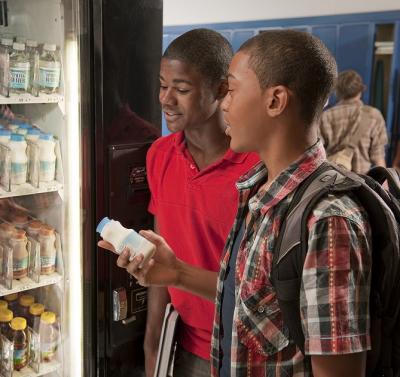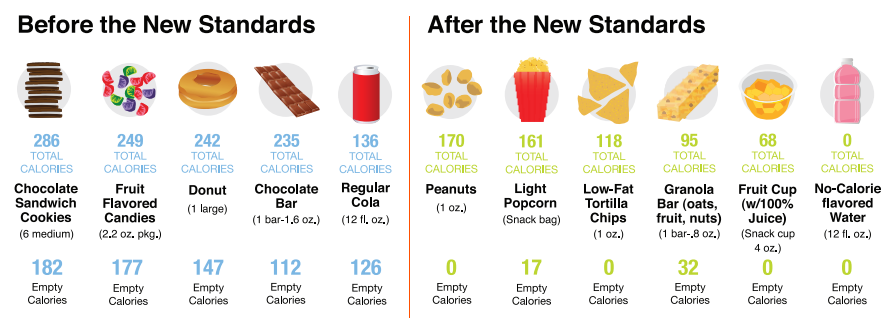Last week, the USDA announced the final four rules released by the Obama administration that implement important aspects of the Healthy, Hunger-Free Kids Act (HHFKA). The legislation has made significant progress across the country in providing more nutritional food to children at school, with the goal of raising a healthier generation. The final four rules pertain specifically to the Smart Snacks standards, local school wellness policies, the Community Eligibility Provisions (which provides free meals to kids in high-poverty areas), and administrative processes.
The Smart Snacks in School final rule requires all snacks sold to children during the school day — including from vending machines, snack bars, and fundraisers — to meet the nutritional quality of the science-based changes that have been made to breakfasts and lunches served in schools since the passage of HHFKA in 2010. The following graphic from USDA illustrates expected changes in snacks sold in schools: snacks with lots of empty calories and sugar, such as cookies and soft drinks are out, and more natural, low-calorie snacks, such as granola bars and fruit cups, are in.
The Smart Snacks in School final rule requires all snacks sold to children during the school day — including from vending machines, snack bars, and fundraisers — to meet the nutritional quality of the science-based changes that have been made to breakfasts and lunches served in schools since the passage of HHFKA in 2010. The following graphic from USDA illustrates expected changes in snacks sold in schools: snacks with lots of empty calories and sugar, such as cookies and soft drinks are out, and more natural, low-calorie snacks, such as granola bars and fruit cups, are in.
The Local School Wellness Policy final rule is essentially a ban on on-campus marketing of junk foods to students. Specifically, it requires that any food or beverage marketed to students during the school day must meet the Smart Snacks standards. According to one study, 70% of elementary and middle school students are exposed to food and beverage marketing while at school. The final rule also mandates that school wellness policies must set nutritional standards for items made available to students—not just sold—at school, which could affect treats given out by teachers as well as classroom parties.
The Community Eligibility Provision (CEP) has been extremely successful in providing free breakfasts and lunches to students who attend schools in high-poverty areas. The final rule makes it easier for students to access these meals by streamlining the administrative process. According to the USDA, more than 18,000 schools in economically distressed areas participate in the CEP, providing free, nutritious meals to 5.2 million students.
Despite it being over five years since HHFKA originally passed, these final rules will help complete the original intentions of the legislation by not only ensuring that all food sold in schools meets the nutritional requirements, but also that the food children are exposed to through advertising meets these guidelines as well. With these rules, the efforts of the Obama administration, and specifically First Lady Michelle Obama’s “Let’s Move!” initiative, are now complete.
However, it should be noted that the Child Nutrition Reauthorization (CNR) is typically updated every 5 years, meaning the newest update is already overdue. The next update of the CNR could very well pull back or weaken many of the requirements set in place, so it’s important to stay informed on the nutrition guidelines set in our schools, and to make your voice heard when the CNR is updated again in the future—especially to encourage more farm-to-school programs so that our children and our communities can experience the benefits of eating local.
What do you think about the final rules? Are they good for our kids, or are they too restrictive? Anything else you’d like to see in school nutrition programs?
The Community Eligibility Provision (CEP) has been extremely successful in providing free breakfasts and lunches to students who attend schools in high-poverty areas. The final rule makes it easier for students to access these meals by streamlining the administrative process. According to the USDA, more than 18,000 schools in economically distressed areas participate in the CEP, providing free, nutritious meals to 5.2 million students.
Despite it being over five years since HHFKA originally passed, these final rules will help complete the original intentions of the legislation by not only ensuring that all food sold in schools meets the nutritional requirements, but also that the food children are exposed to through advertising meets these guidelines as well. With these rules, the efforts of the Obama administration, and specifically First Lady Michelle Obama’s “Let’s Move!” initiative, are now complete.
However, it should be noted that the Child Nutrition Reauthorization (CNR) is typically updated every 5 years, meaning the newest update is already overdue. The next update of the CNR could very well pull back or weaken many of the requirements set in place, so it’s important to stay informed on the nutrition guidelines set in our schools, and to make your voice heard when the CNR is updated again in the future—especially to encourage more farm-to-school programs so that our children and our communities can experience the benefits of eating local.
What do you think about the final rules? Are they good for our kids, or are they too restrictive? Anything else you’d like to see in school nutrition programs?






